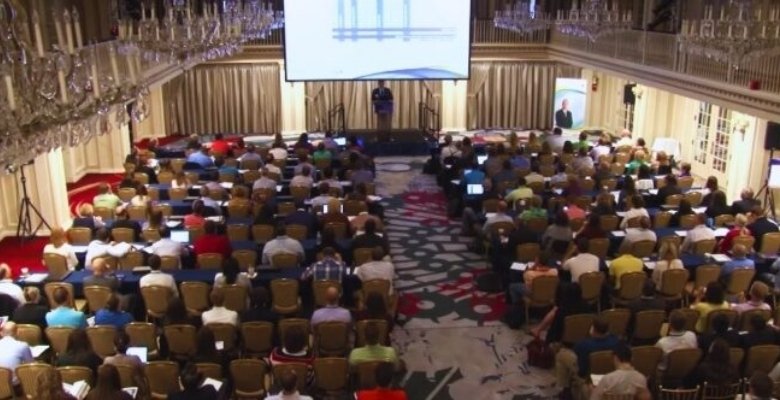Standing in front of a crowd at a conference can feel exciting but also a little tense. Addressing the audience in the right way shapes how they listen and respond to you. The way you open, the words you choose, and the tone you set all matter, which is why a common question appears: How do you address an audience in a conference?
To address an audience at a conference, start with a warm greeting and introduce yourself clearly. Share the purpose of your talk in simple words. Thank the organizers and the people attending. Use a short story or a question to catch their interest. Speak in a friendly way and invite questions at the end.
Want to learn more about doing this the right way? Then keep reading—this article covers everything you need to know about speaking clearly and confidently at a conference.
How Do You Address an Audience in a Conference?
Speaking at a conference can feel exciting and a bit overwhelming at the same time. The way you start and carry yourself has a big impact on how people listen to you. A thoughtful approach builds trust and makes your talk more effective. Let’s look at some simple but powerful steps that can help you learn how to address an audience:
Warm Greeting
Begin with a natural and friendly greeting to set a welcoming mood. A simple “Good morning everyone,” works better than a stiff or overly formal line. Your tone should sound genuine, not forced, so people feel comfortable right away. A warm greeting breaks the ice and opens the door for connection.
Clear Introduction
After greeting, introduce yourself in a simple way. Share your name and one short detail about your background that relates to the talk. Avoid a long list of achievements, as this can bore the audience quickly. A short and clear introduction gives you credibility without wasting time.
Purpose Statement
Tell your conference audience why you are speaking and what they will learn. A clear purpose helps them understand what to expect and keeps their attention. It also gives you a direction to follow throughout the presentation. When people know the goal, they listen more carefully.
Show Gratitude
Thank the organizers for inviting you and the audience for being present. A short note of appreciation builds goodwill and shows respect. Whether it is a local event or a large conference in Canada, people like to feel valued. This also helps you start your talk on a positive note.
Story or Question
Use a short story or ask a simple question related to your topic. Stories make your points relatable and easy to remember. Questions spark curiosity and encourage people to think about the subject. Both methods grab attention and make the audience more alert.
Simple Language
Always use clear and easy words that everyone can understand. Avoid using heavy terms or technical jargon unless you explain them quickly. Simple language keeps the audience with you instead of leaving them confused. When people understand you well, they stay interested longer.
Invite Questions
Before ending, welcome questions or feedback from your audience. This creates a two-way conversation and makes people feel involved. Answer questions in a respectful and short way to keep the session on track. Ending with questions also shows that you value the audience’s thoughts.
Addressing an audience in a conference is not about being perfect but about being clear, respectful, and engaging. Small actions like greeting warmly, sharing a story, and inviting questions can turn a normal talk into a memorable experience. Click the download button to view a sample of how to address an audience during a conference.
Why Does Addressing an Audience Effectively Matter?
Standing up to speak in front of people means your delivery matters just as much as your message. A clear and confident style helps the audience stay engaged and understand you better. If your words are easy to follow, listeners are far more likely to remember them. Let’s explore why this skill is so important and how it can make a real difference.
Builds First Impressions
Your first words and body language tell a lot about you. People quickly decide if they want to listen or not. A calm and friendly start can grab attention in the right way. It shows you are ready and confident. That first impression can set the mood for your whole talk.
Makes Your Message Clear
When you speak clearly and stay on topic, your message becomes easy to understand. Simple words and clear examples help everyone follow along. If people understand your point, they are more likely to remember it. Confused listeners may lose interest fast. So, clear speaking always works better.
Keeps Audience Interested
People enjoy talks that feel personal and easy to follow. When you focus on addressing people at a conference in a direct and simple way, they feel included. Asking questions, sharing short stories, or using examples helps hold attention. The more they stay with you, the better the talk feels for everyone. Keeping their interest is a big win.
Encourages Two-Way Talk
A good speaker often invites questions or quick thoughts from the audience. This makes the talk more like a chat than a lecture. It also helps you know if people are following you or not. Two-way talks make the whole session more fun and active. It’s a great way to connect with others.
Boosts Your Confidence
Knowing how to speak to a group gives you a strong sense of confidence. Instead of worrying about mistakes, you can focus on sharing your ideas clearly. Confidence shows through your tone and body language, and the more assured you are, the more people believe in what you say. This makes your speech even stronger.
Leaves a Strong Finish
How you end your talk matters too. A clear summary or a thoughtful line helps people remember your main point. A strong finish gives your talk a neat ending. It also shows that you planned your message well. People often remember the ending most, so make it count.
Examples of Self-introductions at a Conference You Can Use
Starting your talk at a conference can feel a little tense, but the right introduction makes things easier. A good self-introduction helps the audience know who you are and why you are speaking. It also shows confidence and builds trust. Let’s look at some examples you can use in different conference roles.
Keynote Speaker
“Good morning everyone. My name is ______, and I’m honored to be here today. I work in the field of ______ and have spent the past few years focusing on ways to improve professional communication. My main goal today is to share some key ideas that can help you connect with your audience better. I look forward to walking you through some useful insights.”
Panelist
“Hello everyone, I’m ______, and I work in ______. It’s a privilege to join this panel with such knowledgeable speakers. My role today is to share my perspective on how speakers can hold audience attention in the first few moments. I’ll be adding points based on my own experience, and I look forward to learning from the discussion as well.”
Moderator
“Good afternoon, I’m ______, and I’ll be your moderator for this session. My responsibility is to guide the conversation, make sure each speaker has time to share their views, and also leave room for your questions. I’ll keep the session on track and highlight the key points as we move along. Let’s begin with our first speaker.”
Workshop Lead
“Hi everyone, my name is ______, and I’ll be leading this workshop. I specialize in helping people improve their public speaking skills and audience engagement. In today’s session, we’ll go through a few practical exercises together so you can apply what you learn right away. My aim is to make this session interactive, useful, and enjoyable for all of you.”
The right self-introduction builds trust and sets the tone for your role. Whether you are a keynote speaker, panelist, moderator, or workshop lead, a short and clear opening helps the audience connect with you instantly. To obtain all of these examples of self-introduction in a single file, click the button below.
Body Language and Voice That Help You Connect With Audiences
Speaking at a conference is about more than words; your body and voice often send the strongest signals. How you stand, move, and speak shapes the way people see you. Even with a clear message, weak delivery can make it harder for others to care. That’s why learning small techniques can create a big impact.
- Stand Tall and Steady: Good posture shows confidence and keeps your body balanced. Avoid leaning too much or rocking side to side.
- Use Natural Hand Gestures: Move your hands while talking to highlight your points. Keep it relaxed and avoid stiff or overactive movements.
- Keep Eye Contact: Look at different parts of the room, not just one spot. This helps people feel like you are talking to them.
- Smile When Needed: Smiling at the right time makes you look friendly and open. It also helps calm your nerves while speaking.
- Control Your Voice: Speak clearly and with steady volume, not too fast or too low. People listen better when your voice sounds sure.
- Use Pauses Wisely: Take short pauses after key points to let them sink in. This also helps you slow down and stay in control.
- Avoid Closed Body Signals: Try not to cross your arms or turn away from the audience. An open body posture makes you look more inviting.
- Match Tone with Topic: Use a warm tone for casual talks and a firm tone for serious points. This helps set the right mood for your message.
Does Effective Speaking Help Grow Conference Attendance?
Yes, effective speaking can boost conference attendance in the future. When a speaker connects well with the audience, they create a lasting impression. People enjoy talks that feel real, useful, and easy to follow from start to end. A strong speech can make attendees want to come back and bring others with them.
Speakers who speak clearly and confidently help build the event’s image over time. Audiences remember how they felt during a talk, not just the topic. If the speaker was engaging, friendly, and clear, people are more likely to trust the event again. One of the best ways to increase conference attendance is by offering speakers who know how to keep people interested.
When someone enjoys a session, they often talk about it with friends, coworkers, or online followers. This kind of simple word-of-mouth can grow future audiences. Good speaking adds value to the overall event, making it stand out from other conferences. So yes, effective speaking is a smart and natural way to boost attendance long-term.
How to Close Your Talk Effectively at a Conference?
The way you end your talk can leave a stronger mark than the start. A clear and confident close helps people remember your key points. It also shows respect for their time and attention. Let’s look at some simple methods to end your conference talk in the best way.
Summarize Key Points
Wrap up by repeating the most important ideas from your talk. A quick summary helps people remember what matters most. Keep it short and direct, not a second speech. Clear summaries give your audience something solid to take away.
Call to Action
End by telling the audience what they can do next. This could be applying a tip or starting a discussion. A call to action makes your talk feel useful beyond the room. It also gives your audience a reason to think about your message later.
Thank the Audience
Always show appreciation to the people who gave their time to listen. A simple thank you feels sincere and respectful. It reminds people that their presence matters to you. Gratitude is a small act that leaves a warm impact.
Invite Questions
Before leaving the stage, invite questions from the audience. This makes your talk more interactive and clears any doubts. Keep answers short to respect time and include everyone. Question time shows that you value the opinions of others.
Strong Closing Line
Prepare one powerful line to end with. It could be a short quote, a clear reminder, or a hopeful thought. The last sentence should be easy to remember. A strong closing line can stay with the audience long after the talk.
End with Confidence
Stand tall, smile, and maintain eye contact before leaving the stage. Body language is part of your closing as well. Confidence at the end helps the audience believe in your message. It also makes your overall talk feel complete and polished.
Frequently Asked Questions
Public speaking often brings up many small details people want to know. While the main steps are clear, there are other questions that speakers often think about. Below are some practical FAQs to help you prepare even better.
How Important Is Timing in a Conference Speech?
Timing plays a major role in how your audience receives your message. Speaking too long can cause people to lose focus, while speaking too short may leave gaps. Sticking to the allotted time shows respect for the event and listeners. Proper timing helps maintain energy and balance throughout your talk.
What Should You Do Before Going on Stage?
Before stepping on stage, take a few minutes to calm yourself and review your opening lines. Check the microphone, slides, or any other tools you will use. Deep breathing can also help reduce nervousness. Preparation before speaking sets you up for confidence once you start.
How Do Visual Aids Improve Engagement?
Visual aids such as slides, charts, or props help make ideas easier to understand. They break down complex information into simple visuals. Clear and minimal designs work best, since too much text can distract. Using visuals effectively keeps your audience focused and interested.
Can Humor Be Used in Conference Talks?
Humor can work well if used naturally and at the right moment. A light joke can relax the room and make you more relatable. However, humor must fit the topic and respect cultural differences. Done correctly, it makes talks more enjoyable and memorable.
How Should You Handle Technical Problems While Speaking?
Technical issues can happen anytime during a presentation, but staying calm is the key. If slides stop working, continue speaking without them. Always prepare a backup, such as printed notes or a summary. Handling issues calmly shows professionalism and resilience to the audience.
Why Is Audience Eye Contact So Powerful?
Eye contact shows confidence and sincerity, helping you connect on a personal level. It makes each person feel included in your message. Moving your gaze around ensures no one feels ignored. Consistent eye contact strengthens trust between you and your audience.
What Role Does Body Movement Play?
Body movement helps bring energy and keeps people watching you instead of drifting away. Moving naturally across the stage adds variety. However, overdoing it can distract from your message. Balanced movement creates a lively but professional presence in front of the audience.
Bottom Line
Connecting with an audience doesn’t require fancy words or perfect skills—it just needs honesty, preparation, and a little practice. When you speak from the heart and stay clear in your message, people listen, understand, and remember. Every moment you spend learning this skill adds more value to your voice.
Whether you’re opening with a story, thanking your listeners, or closing with a strong final line, these small choices make a big difference. The best speakers aren’t always the loudest—they’re the ones who speak with care, purpose, and respect. That’s what truly holds attention in a room full of people.
So, if you’re still thinking about how do you address an audience in a conference, just remember: speak clearly, speak kindly, and speak like you mean it. The rest will follow.








